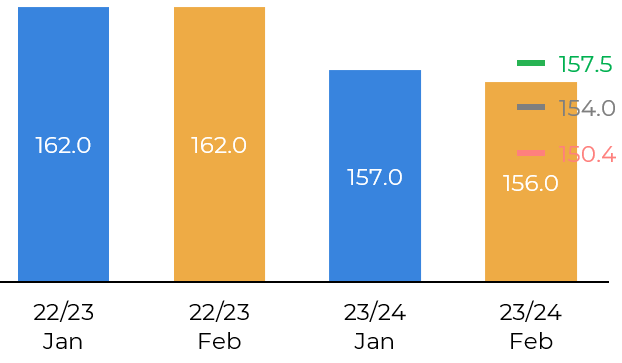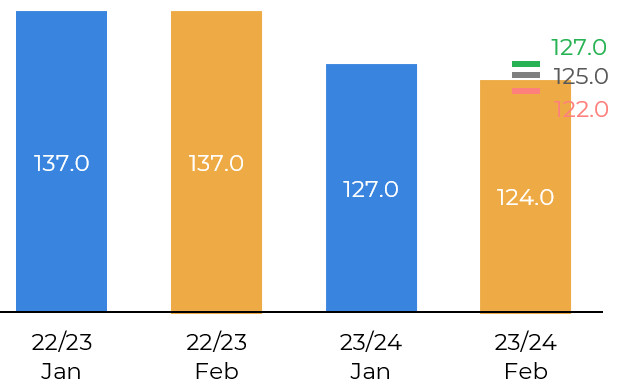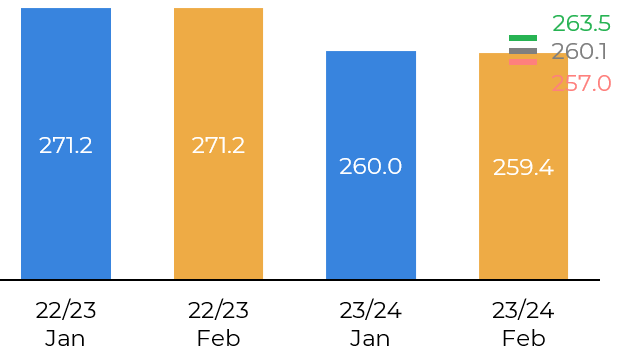
Feb 8
/
Alef Dias and Thais Italiani
Post-WASDE Monthly Report - 2024 02 08
Back to main blog page
"Results of USDA's February report"
Soybeans: Brazil in the spotlight and the divergence between agencies
Figure 1: Brazil Soybean - Production (M ton)

The USDA, as usual, didn't make many changes to its US Supply and Demand estimate for February. Only exports were reduced due to two factors: the concerns over slow pace of shipments at US ports in January and the competition with Brazil.
Speaking of Brazil, the cut in the soybean production estimate happened as expected, but to a lesser extent. While agents on average pointed to a cut of 3M mt, the USDA was more conservative and reduced it by just 1M mt to 156M mt.
This movement, combined with Conab's update today, has increased the difference between the two readings. While the USDA expects the Brazilian crop to reach 156M mt, Conab is already working below 150M mt, with an estimate of 149.4M mt, a difference of 6.6M mt.
Corn: Brazil takes the spotlight
Figure 2: Brazil Corn - Production (M ton)

Fig. 3: EU wheat - Area, yield and production (M ha, mt/ha, M mt)
Along the same lines as soybeans, the USDA made only marginal adjustments to the US corn balance. Consumption of corn for use in food, seeds, and industry was reduced, reflecting higher stocks. Exports remained unchanged, contrary to expectations.
Looking at South America, where supply is the center of attention at the moment, Argentina's crop estimate remained stable at 55M mt, while Brazil's was reduced from 127 to 124M mt. Although this was in line with market expectations, the fact that Conab has already lowered its crop projection further calls into question the US department’s estimate.
Conab projects Brazil's corn crop at 113.7M mt (down 3.9M mt vs January) and 10.3M mt below the USDA.
Wheat: more production with tighter stocks
Figure 3: World Wheat - Ending Stocks (M ton)

For wheat, it was a calm WASDE, but the changes were more bearish in general. Despite slightly tighter than expected world ending stocks, global production estimates actually increased month-on-month, with Argentina being the main upward adjustment (+0.5M mt - in line with local estimates).
The drop in ending stocks was led by higher demand in India, where the government continues to sell reserves to deal with inflation. The country's domestic use was raised by 1M mt. Trade flows leaned to the bearish side with a 2M mt increase in exports from Ukraine (which continues to have competitive prices due to high stocks). Argentina and Australia also had their export estimates increased.
Finally, US ending stocks were seen looser than expected, as food use was reduced by 10M bu due to lower wheat milling, as indicated in the NASS Flour Milling Products report released on February 1.
Charts Legend

WASDE Commentary — Grains
Written by Thaís Italiani
thais.italiani@hedgepointglobal.com
thais.italiani@hedgepointglobal.com
Disclaimer
This document has been prepared by hEDGEpoint Global Markets LLC and its affiliates ("HPGM") exclusively for informational and instructional purposes, without the purpose of creating obligations or commitments with third parties, and is not intended to promote an offer, or solicitation of an offer, to sell or buy any securities or investment products. HPGM and its associates expressly disclaim any use of the information contained herein that may result in direct or indirect damage of any kind. If you have any questions that are not resolved in the first instance of contact with the client (client.services@hedgepointglobal.com), please contact our internal ombudsman channel (ouvidoria@hedgepointglobal.com) or 0800-878-8408 (for clients in Brazil only).
Contact us
hedgepointhub.support@hedgepointglobal.com
ouvidoria@hedgepointglobal.com
Funchal Street, 418, 18º floor - Vila Olímpia São Paulo, SP, Brasil
This page has been prepared by Hedgepoint Schweiz AG and its affiliates (“Hedgepoint”) solely for informational and instructional purposes, without the purpose of instituting obligations or commitments to third parties, nor is it intended to promote an offer, or solicitation of an offer of sale or purchase relating to any securities, commodities interests or investment products. Hedgepoint and its associates expressly disclaim any use of the information contained herein that directly or indirectly result in damages or damages of any kind. Information is obtained from sources which we believe to be reliable, but we do not warrant or guarantee the timeliness or accuracy of this information. The trading of commodities interests such as futures, options, and swaps involves substantial risk of loss and may not be suitable for all investors. You should carefully consider wither such trading is suitable for you in light of your financial condition. Past performance is not necessarily indicative of future results. Customers should rely on their own independent judgement and/or advisors before entering in any transaction.Hedgepoint does not provide legal, tax or accounting advice and you are responsible for seeking any such advice separately.Hedgepoint Schweiz AG is organized, incorporated, and existing under the laws of Switzerland, is filiated to ARIF, the Association Romande des Intermédiaires Financiers, which is a FINMA-authorized Self-Regulatory Organization. Hedgepoint Commodities LLC is organized, incorporated, and existing under the laws of the USA, and is authorized and regulated by the Commodity Futures Trading Commission (CFTC) and a member of the National Futures Association (NFA) to act as an Introducing Broker and Commodity Trading Advisor. HedgePoint Global Markets Limited is Regulated by the Dubai Financial Services Authority. The content is directed at Professional Clients and not Retail Clients. Hedgepoint Global Markets PTE. Ltd is organized, incorporated, and existing under the laws of Singapore, exempted from obtaining a financial services license as per the Second Schedule of the Securities and Futures (Licensing and Conduct of Business) Act, by the Monetary Authority of Singapore (MAS). Hedgepoint Global Markets DTVM Ltda. is authorized and regulated in Brazil by the Central Bank of Brazil (BCB) and the Brazilian Securities Commission (CVM). Hedgepoint Serviços Ltda. is organized, incorporated, and existing under the laws of Brazil. Hedgepoint Global Markets S.A. is organized, incorporated, and existing under the laws of Uruguay. In case of questions not resolved by the first instance of customer contact (client.services@Hedgepointglobal.com), please contact internal ombudsman channel (ombudsman@hedgepointglobal.com – global or ouvidoria@hedgepointglobal.com – Brazil only) or call 0800-8788408 (Brazil only).Integrity, ethics, and transparency are values that guide our culture. To further strengthen our practices, Hedgepoint has a whistleblower channel for employees and third-parties by e-mail ethicline@hedgepointglobal.com or forms Ethic Line – Hedgepoint Global Markets.Security note: All contacts with customers and partners are conducted exclusively through our domain @hedgepointglobal.com. Do not accept any information, bills, statements or requests from different domains and pay special attention to any variations in letters or spelling, as they may indicate a fraudulent situation.“HedgePoint” and the “HedgePoint” logo are marks for the exclusive use of HedgePoint and/or its affiliates. Use or reproduction is prohibited, unless expressly authorized by HedgePoint. Furthermore, the use of any other marks in this document has been authorized for identification purposes only. It does not, therefore, imply any rights of HedgePoint in these marks or imply endorsement, association or seal by the owners of these marks with HedgePoint or its affiliates.

